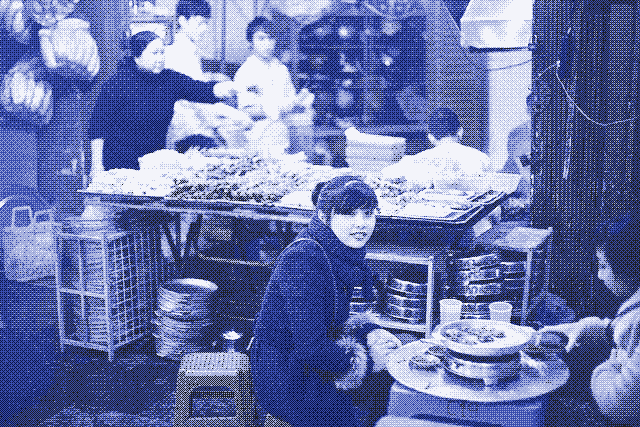
The food system in the industrialised world is based on mass-production, global distribution, and constant refrigeration. It requires many resources and produces a lot of food waste. Aaron Vansintjan takes to the streets of Hanoi, where the Vietnamese practice a food culture based largely on fermentation.
Although food spoils much faster in a tropical climate, the Vietnamese will often store it without refrigeration, and instead take advantage of controlled decay. Vietnam’s decentralised food system has low energy inputs and reduced food waste, giving us a glimpse of what an alternative food system might look like.
Tropical Climate
In a tropical climate, everything decays faster. Bread gets soft and mushy, milk spoils, the walls get moldy just months after a layer of fresh paint. Food poisoning is a constant concern. The heat and moisture make for an ideal breeding ground for bacteria and fungi. In this environment, you’d think people would be wary of any food product that smells funny. But in tropical Vietnam, food can get pretty pungent.
Take mắm tôm, a purplish paste made of fermented pureed shrimp. Cracking open a jar will result in a distinct smell of ‘there’s something wrong here’ with hints of marmite to whelm through the whole room. You have chao, a stinky fermented tofu, which was so rank that the smallest bite shot up my nose and incinerated my taste buds for an hour (‘Clears the palate!’ said the waiter encouragingly).
Consider rượu nếp, which is sticky rice mixed with yeast and left to ferment for several days ‘in a warm place’—i.e. the counter. The result is a funky-smelling desert—literally rice left to rot until it turns in to a sweet wine pudding. On the 5th of May of the lunar calendar, Vietnamese people will eat rượu nếp in the morning to celebrate ‘inner parasite killing day’. Bonus: day-drunk by the time you arrive at work.
We shouldn’t forget Vietnam’s world-famous fish sauce — nước mắm — made from diluted fermented fish, a flavour that many people around the world continue to find totally intolerable.
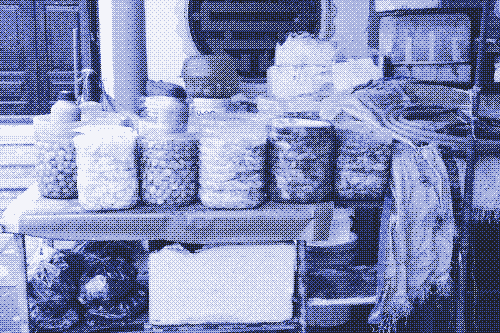
In Vietnam, putrefaction is accepted as a part of life, even encouraged. But fermentation in Vietnam isn’t just an odd quirk in a tropical diet. To understand why fermentation is so integral to Vietnamese culture, you have to consider how it is embedded within people’s livelihoods, local agricultural systems, food safety practices, and a culture obsessed with gastronomy; where food is seen as a social glue. And when you bring together all these different puzzle pieces, an enchanting picture emerges: one in which fermentation can be a fundamental component of a sustainable food system.
Unlike many high-tech proposals like ‘smart’ food recycling apps, highly efficient logistics systems, and food packaging innovations, fermentation is both low-tech and democratic—anyone can do it. What’s more, it has low energy inputs, brings people together, is hygienic and healthy, and can reduce food waste.
Rotting Food can be Safe and Healthy
At the entrance of a market in Hanoi, a woman with a dưa chua stand tells us that making ‘sour vegetables’ is easy: you just add salt to some cabbage and let it sit for a couple of days. As we talk, several customers come by, eager to scoop some brine and cabbage into a plastic bag. Worried that we’re discouraging her customers, she shoos us away. She isn’t lacking business.
Is fermentation really so effortless? The short answer is yes. Many recipes will call for two things: water and salt. At just a 1:50 ratio (2%) of salt to food, you can create an environment undesireable for all the bad bacteria and encourage all the good ones. Sauerkraut, kimchi, fish sauce, sriracha, and kosher dill pickles—are all made according to this principle.
Yet other types of fermentation are a bit more complicated. They call for sugar (e.g. wild fermented alcohol like ethiopian honey wine), yeast starters (rượu nếp, most wines and beers), special fungi (tempeh, miso), or some kind of combination of fungi, bacteria, salt, or sugar (kombucha). Yet others are simpler: to make cooking vinegar, just let that bottle of bad wine sit for a couple of days, and to make sourdough, just mix water and flour and leave it on your counter.
Fermentation is both low-tech and democratic. It can be a fundamental component of a sustainable food system
All in all, fermentation is just controlled decay: your most important ingredient is time. This can sound like a bit too much, too fast. Take the woman I met at the entrance of the market. Her dưa chua, while in great demand, looks like wilted cabbage, soppy, floating in murky brine. Some bubbles are forming on the edges of the plastic container—for the trained eye a sign of an active fermentation process, but for the uninitiated, an alarm bell.
There’s no use beating about the bush. That dưa chua is in fact rotting in a very similar way that a peat swamp is constantly rotting, belching large doses of methane into the world. What’s happening is an anaerobic fermentation—that is, without significant amounts of oxygen. This absence of oxygen and the high levels of salt creates an environment supportive to several bacteria that also find their home in our own digestive systems.
Those bubbles forming in the container are by-products of these bacteria: CO2 and methane. The bacteria also lower the pH and start breaking down raw food—essentially pre-digesting it for you. And, once the pH goes down even lower, you’ve created a monster so voracious that no other fungus, bacteria, or parasite with bad intentions will dare to enter its domain. So yes, it’s rotting just like a stinky swamp, and that’s a good thing.
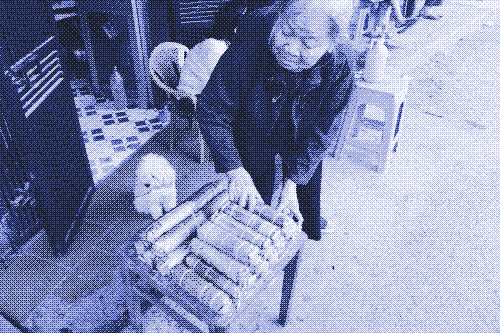
It’s a good thing especially in a climate like that of Vietnam. Every fermentation is a small victory against the constant war against heat and humidity, which destroys all edibles in its path. Instead of eating raw cabbage and risking death by a thousand E. Coli, you can eat fermented cabbage and know, for a fact, that it won’t have you hunkering by the toilet bowl any time soon.
Not only that, but eating fermented food has significant health benefits. You might’ve noticed the new fad of ‘pro-biotic’—well all that really means is that the product contains some kind of active bacterial culture that looks like the flora in your own stomach. That would include, not just Go-gurt, Yoplait, Chobani, and Danone, but also several kinds of cheese, pickles, beer, and just about any other fermented product.
Eat about a tablespoon of any of these at the end of every meal, and you inoculate your stomach with a fresh batch of microbes that help you digest—all the more necessary when we eat antibiotics in our meat and bland diets of white bread and peanut butter, and drink chlorine in most municipal water systems.
Further, products like fish sauce and shrimp paste provide many impoverished Vietnamese with micro-nutrients, B-12 vitamin, proteins, and omega 3 fatty acids—comprising a significant part of people’s nutritional requirements. For a country that still remembers hunger and starvation, this is no small fry.
A Diverse Food System
In the same market we talk to a vegetable vendor. Real estate in the neighborhood is getting more expensive, rents are going up. She’s having a hard time making ends meet. On her street many elderly have sold their farmland—which they used to grow vegetables and decorative flowers—and now, unemployed, they spend their time selling home-made fermented vegetables out of their front door.
In the same neighborhood, we meet Tuan, an elderly woman growing vegetables in the banks of a drained pond. She rarely goes to the market—she can grow much of her own food in this little patch. We ask her if she ever ferments her vegetables. Of course, but she doesn’t sell them—they’re just for herself and her family.
If you want a localised food system, you need to be able to store your food for long periods. Fermentation makes that possible.
After several months of studying Hanoi’s food system and the people who make their living off of it, Vân (my Vietnamese collaborator) and I are starting to see some patterns. In Western countries, the food system is shaped a bit like an hourglass: industrial farmers send their food to a supplier, who then engages with a handful of supermarket companies, who then sell to consumers.
In Vietnam, on the other hand, it looks more like an intricate web: wholesale night markets, mobile street vendors, covered markets, food baskets organized by office workers with family connections to farmers, guerilla gardening on vacant land. Food is grown, sold, and bought all over the place, and supermarkets are just a small (albeit growing) node in the complex latticework. Most people still get food at the market, but many also source their food from family connections.

In Vietnam, many people might have one ‘profession’, but when you ask a bit more questions it’ll turn out that they have half a dozen other jobs for ‘extra income’. There’s a generalised ‘hustle’: everyone is a bit of an entrepreneur. After talking with Tuan for several hours, we learned that she has, throughout her long life, fished, grown vegetables, corn, and fruit trees, sold rice noodles, bread, ice cream, roses, and silk worms. Now, aged 68, she grows decorative peach trees and grows vegetables when she can.
With an economy just decades shy of a highly regulated communist regime where the only food you could get was through rations, and the memory of famine still fresh in people’s mind, this is entirely understandable: with a finger in every pot, you can just about manage to survive. These two factors, a highly distributed food system and diversified livelihoods, make for a fertile environment for fermentation practices. With easy access to wholesale produce, many can turn to small-scale fermentation to compliment their income—or, in the case of Tuan, to spend less on food at the market.
Preserving the Harvest, Bringing People Together
Vietnam hosts both the Red River delta and the Mekong delta—two of the most productive agricultural regions in the world. The heat and the vast water supply allow some areas of Vietnam to have three full growing seasons. That means three harvests, and that means lots of food at peak times, and sometimes so much that you can’t eat it all. That’s another bonus of fermentation: if your food system is local, you’re bound to stick to seasonal consumption. But by fermenting your harvest you can eat it slowly, over a long time period. It’s this principle that underlies much of fermentation culture in East Asia.
Take kim chi, a spicy fermented cabbage from Korea. Traditionally, the whole village would come together to chop, soak, salt, and spice the cabbage harvest every year. Then, these mass quantities of salted spicy cabbage were stored in large earthenware pots underground—where cooler temperatures lead to a more stable fermentation process. As a result, you can have your cabbage all year. If you want a localised food system, you need to be able to store your food for long periods. Fermentation makes that possible.
Food fermentation is a strange thing: it inverts what many regard as waste and turns it into a social, living, edible object.
Fermentation is also social. Fermenting large batches of summer’s bounty typically requires hours of chopping—the more the merrier. And chopping is the perfect time for sharing cooking tips, family news, and the latest gossip. In South Korea, now that kim chi production has been largely industrialized, people try to relive the social aspect of making it through massive kim chi parties in public spaces.

In a country like Vietnam, where a traditional food system still exists for a large part, fermentation remains embedded in social relations. Relatives and neighbors constantly gift each other fermented vegetables, and many dinners end with a batch of someone’s homebrewed rice wine—rượu men. Fermentation lends itself well to a gift economy: there is pride in your own creation, but there is also no shame in re-gifting. And because of its low costs, anyone can take part in it.
Gastronomy, Tested with Time
It is a bit disingenuous to caricature Vietnam’s food culture as obsessed with rotting, and suggest that this is largely the result of a tropical climate. Rather, what we’re dealing here is difference in taste: what may seem strange and pungent to one culture is highly appreciated in another. In fact, one of the greatest impressions I have of Vietnamese culture is its deep appreciation for gastronomy: subtle, complex flavours, considered textures, modest spicing and well-balanced contrasts define Vietnamese cuisine.
Fermentation is a crucial part of this culture: the art of fermentation requires paying attention to how flavours change as food transforms, understanding these chemical shifts and using them to achieve a desired affect. It’s also clear that Vietnamese gastronomy is popular: it takes place in street food stalls, run by enterprising matriarchs, constantly experimenting with modern products and traditional flavors. It is cheap and, to ensure customer loyalty, it is surprisingly hygienic.
Street vendors rarely have fridges, nor do they have large cooking surfaces, dishwashing machines, or ovens. By and large, they make do with some knives, two bowls to wash fresh vegetables in, a large pot, a frying pan, coals or gas burners and—for products that may go bad during the day—fermentation. Having limited access to capital and consumer electronics, these vendors—most often women—ply their trade in a way that has stood the test of time.
They know the rules of hygiene and food safety, and, because they have to be careful with their money, they know exactly what kinds of food will go bad, and what kinds of food can be preserved. In doing so, they practice a food culture that has been passed down through generations—to a time before fridges, a global food system powered by container shipping, factory trawlers, and produce delivered to far-off markets by airplane.
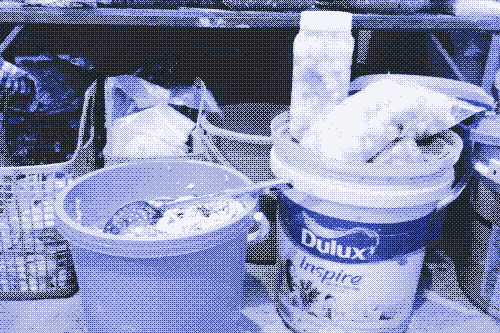
While modern technology has provided many benefits for our diets, there are many innovations from the past that have been abandoned as the global food system was transformed by the availability of cheap fuel. One such innovation was the fish sauce industry that flourished during Ancient Roman times. For Romans, fermenting fish was a crucial aspect of a low-tech and seasonally-bound food system. In fact, it so happens that research now suggests Vietnamese fish sauce may actually have its origins in the Roman variant produced over 2,000 years ago.
Today, however, fermentation doesn’t fit so easily within the global food system. Harold McGee at Lucky Peach tells the story of how canned products were notoriously difficult to transport in the newly industrialized food system of the 19th century. Apparently, until the 20th century, metal cans would regularly explode, sending shrapnel and preserved tuna flying through the decks of transport ships. This was due to heat-resistant bacteria, which continued fermenting the product long after it was heat-treated.
Fermented food has to be produced locally: transporting it will risk explosions on the high seas
The solution was to subject the canned product to high temperatures over a long period of time, killing all remaining cultures, in turn changing their flavor. But in the case of fermented food, the problem has not gone away: if you want it to be actively fermenting, transporting it will risk explosions on the high seas. But heating stops the fermentation process, and kills its unique flavor.
It’s for this reason that products like kim chi, kombucha, and sauerkraut often have to be produced locally, despite increasing global demand. In some way, fermentation belies the industrial food system: the fact that it is alive means that it doesn’t quite fit in. You either have to kill it, thereby change it, or it will keep bubbling through the cracks.
A Low-tech Food System is Possible
Fermentation cultures in Vietnam give us a glimpse of what an alternative food system might look like, one that is both decentralized and doesn’t depend on high inputs of fossil fuel energy to preserve food, high waste, and high-tech. Why does this matter? Well, in a world facing climate change, we need a low-impact food system, and fast.
But there are other reasons: with increasing concern over the health side effects of common chemicals such as BPA, found in almost all cans and pasta sauce jars, people are looking to safer kinds of preservation, which aren’t killing them and their families slowly. And with the rise of the local food and food sovereignty movements, many are realising that we need food systems that support everyone: from small farmers to low-income families.
Because of its low investment costs, fermentation lends itself well to supporting small businesses, allowing them to take advantage of seasonality while practicing a time-tested low-tech method of food preparation. Today, in response to increasing food insecurity, we are hearing increasing calls for a smarter, more efficient food system. Proposals such as intensive hydroponic and vertical farming, big data-powered logistics systems, smart agriculture technologies, and food waste recycling apps clog the news.
But we already have a low-tech innovation that works very well. Fermentation, because it is accessible to everyone, because of its low energy requirements, and because it fits right in to a more sustainable food system, should not be abandoned in the search for global food security.
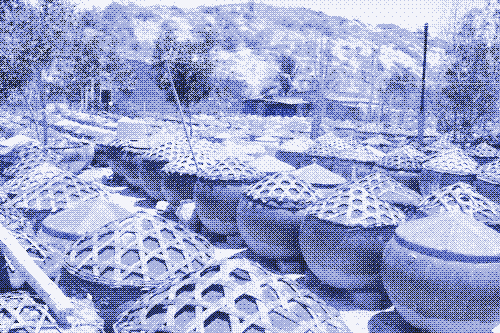
It’s easy to get the impression that we live in a world of scarcity, where there just isn’t enough food to go around, and food production all around the world is limited by technological backwardness. On the other hand, many of us are more and more concerned with the increasing problem of food waste in Western food systems. We seem to live in a world of both scarcity and abundance at the same time.
Food fermentation is a strange thing: it inverts what many regard as waste and turns it into a social, living, edible object. As a friend of mine once said, if you have too many grapes, you make wine. If you have too much wine, you throw a party. If you still have too much wine, you make vinegar. Fermentation turns scarcity and abundance on its head, belying easy categories of what is waste and what is too much.
Sustainability advocates worry a lot about making the ‘supply chain’ more ‘efficient’—that is, increasing profits margins while making sure all food reaching consumers in a perfectly fresh state. Instead, we could consider taking advantage of decay. This isn’t hard: you just have to add some salt and water. We’ve done it for thousands of years, and, if we follow the example of food cultures like those in Vietnam, we can do it again.
Aaron Vansintjan
Reactions
To make a comment, please send an e-mail to solar (at) lowtechmagazine (dot) com. Your e-mail address is not used for other purposes, and will be deleted after the comment is published. If you don’t want your real name to be published, sign the e-mail with the name you want to appear.
Reactions
D
Even in the West eating fermented foods is common. Common drinks and foodstuffs such as wine, bread, mustard and ketchup are fermented products.
kris de decker
@ Sigunas
That’s a very good point. Low-tech alternatives are always local alternatives, taking into account geography, climate and culture. Although fermentation also played an important role in moderate and cold climates in earlier times, people could store a lot of their food underground.
Even without ice cubes, cellars could store produce for a long time, see for instance the root cellar. In hot and arid environments people dry a lot of food, like the famous Jamón ibérico (Iberian ham). And in the tropics, it’s mainly fermentation.
The problem is that all these lowtech alternatives have been replaced, or are being replaced, by a system based on electric refrigeration. Fossil fuel alternatives are always global, ignoring the local geography, climate and culture.
It’s true that refrigeration requires more energy in tropical regions, but it’s also wasting a lot of energy in cold zones because there people forgot to take advantage of the underground.
Carla
Thank you for an interesting and informative article.
Glen
Sandor Katz is a useful and entertaining connection here: an American who’s written several books on fermentation and maintains a website of useful links and recipes. http://www.wildfermentation.com/
Also, two small misspellings: “desert” should be “dessert” and “compliment” should be “complement.”
Thanks for the article.
Kostas
There is some negative data about kimchi and kombucha:
http://nutritionfacts.org/video/is-kimchi-good-for-you/
http://nutritionfacts.org/video/is-kombucha-tea-goodfor-you/
Dave from San Antonio
Excellent article! The ‘West’ has a lot to learn, but this process takes the “know-how” of years of involvement and social interaction to learn to do this the right way.
thomas reis
Prof callum explains in his “oceans of life” how in Ancient Rome they made their fish soup. Maybe most know the pots in the ground in Italy used to brew fish soup. Still today in Croatia they ferment fish with oil with no boiling just fermenting - tasty.
Berkana
A couple of years ago, I wrote a primer on fermentation that may be of interest to you in light of this topic:
http://www.instructables.com/id/Kimchee-Party-A-recipe-and-a-primer-on-fermentatio/
One of the aspects of fermentation that I found interesting is the three way war between the main types of fermentation microbes: yeast, bacteria, and molds. I described it this way in my primer:
–––––––––––––––––
How fermentation preserves food:
One form of filth kills another form of filth
Fermentation is best described as human intervention into a three way microbial war for the purpose of preserving food and enhancing its flavor. These are the three major combatants in this microbial war:
Yeast, which produce alcohol that kills bacteria and molds
Bacteria, whichproduce acids that kill molds and yeast
Molds, which produce digestive enzymes and antibiotics that kill yeast and bacteria
These three battle for supremacy over who gets to take over our food, and in the course of doing so, produce substances which fend off the colonization and growth of the others, particularly the decomposers. This microbial chemical warfare is memorably summarized by the observation that one form of filth kills another form of filth. What we do when we ferment is to make alliances with the microbe of our choice by creating conditions favorable to that particular kind of microbe so that they can take over our food; in exchange for letting them utilize some of the calories in the food, we utilize their natural defenses to ward off unwanted microbes that would decompose the food or cause food poisoning. ––––––––––––––––––
I think you may enjoy the primer.
Gregor
While reading this interesting text, I was eating my salad with home-made sauerkraut, which consists of two types of cabbage, carrots, onions, apples and so on. And tonight I am going to drink… it doesn’t have an English name I think, it is a “juice” from fermented beets (roots). And yet I live in one of the richest countries in the worlds and enjoy modern job and modern apartment.
Sigunas
I don’t agree with article. In colder climate zone food freezing is not that wasteful, as it would be in Vietnam. And fermentation, at least in northern part, is not that efficient as in south, except for select products, like cheese, beer, wine. If fermentation would be better, our ancestors used it much more. By the way, I remember as my grandmother described how dairy of the beginning of the XX century worked. They had big basements, where big ice cubes, cut from nearby lake in winter, were stored. Fresh milk could be stored in dairy basement for at least a week, if needed.
Regret
@ Sigunas
In colder climate zones milk is best stored as milk for a few days, as yoghurt 6+ weeks (or as long as you can keep adding milk to keep the culture alive), and as cheese for months, up to years depending on the type.
And now I’m hungry.
Pierre
If fermentation releases CO2 or methane, is it really more ecofriendly than using electrical refrigeration? Has anyone done the math?
Thanks for interesting article.
Aaron
@D
There are many fermented products in the west. Even coffee beans have to be fermented before we can drink them. However, most of these products are either pasteurized or no longer are full fermentations—they rely on vinegar rather than fermentation itself. Mustard and ketchup for example, can’t be considered to be actively fermenting. In a Western supermarket, you’ll be hard-pressed to find an active fermentation except for some yoghurts. Even pickles are no longer fermented but rather pickled with vinegar, and therefore not probiotic. I’ve heard however that a Jewish gherkin is probiotic, but I can’t be sure.
@Kostas
It’s true that there is much research showing some negative effects of eating probiotic (active fermentation) products. Much of this research comes from South Korea, where there are lots of statistics correlating kimchi consumption with prevalence of stomach cancers, especially in young men. However while kimchi is probiotic it also has very low pH, and eating too much of that can be taxing for the stomach—likewise with kombucha. Most doctors and nutritionists will recommend minimal consumption of probiotics, up to two tablespoons per meal. This is enough to inoculate the stomach with a new batch of bacteria, while not being too basic.
@thomas reis
Certainly! I wrote an article about fish sauce here: http://www.notechmagazine.com/2015/10/garum-fermented-fish-sauce-for-the-ancient-roman-masses.html
@Berkana
I think you’re probably correct. I looked into it and it seems that in general most lacto-fermentations don’t produce methane in their first stages, however, if you allow the fermentation to go along they will start producing methane over time. However, as most anaerobic fermentation processes are actually a mix of different bacteria, it’s likely that a negligible amount of methane is produced when you ferment cabbage.
@Sigunas
Kris already responded to your comment but I have my own to add.
In fact Western cultures have many forms of fermentation. Fermentation is very common in Scandinavia (fermented herring) and Germany (sauerkraut). While my article might seem to insinuate that the hotter the climate, the more amenable to fermentation, I don’t think this is actually the case. Many fermentations are in fact easier to preserve in colder climates, because they provide a stable environment (for example kim chi, which I mentioned in the article). Even if we could rely on colder outside air temperature to keep products cool, fermentation would still be very useful. To reiterate @Regret’s point, you might be able to store fresh milk for a week in a cellar using ice blocks (which required a lot of energy to produce or transport from mountainous areas), but a fermented dairy product (cheese, yoghurt, sour cream) would last a lot longer (6+ weeks). As @Kris says, if we are serious about limiting energy use today, fermentation can help just a little bit.
Joshua Spodek
This post helped inspire a podcast episode I did on resilience, “Why Unplug?” https://shows.acast.com/leadership-and-the-environment/episodes/426-why-unpug based on my changing my behavior to see what was possible living without a refrigerator for a few months.
Darian Sylvester
Great piece. I am new to the Lo-Tech site, and have been instantly hooked. Interesting comments later in the article that draw attention to market-driven solutions, that inherently feed off profit, not solutions. Of course, you can have one then the other, but why attach profit to the equation at all? A damming coincidence that societies deemed underdeveloped adopt solutions more logical than we (I’m in US) developed western societies.
Joshua Spodek
Updating my last comment, I’m into my second year with the fridge unplugged. I’ve expanded to disconnect my entire apartment from the electric grid in Manhattan, soon to start my sixth month.
This article prompted me most. I’ve shared more on my podcast. Here’s an episode on the experiment off-grid in Manhattan, with links to other episodes: https://shows.acast.com/leadership-and-the-environment/episodes/615-living-off-the-grid-without-solar-either-traditionally.
The New Yorker magazine printed a letter I wrote them in response to a piece of theirs on people bringing more refrigeration to Africa: https://joshuaspodek.com/the-new-yorker-published-my-letter
Before trying, I believed what I’m doing would have been impossible. Instead, it gets easier and more fun with practice. Since more than half the world lives in cities, if they believe what I’m doing is impossible, they won’t try. I hope you try. It’s deeply rewarding and connects us with other cultures distant in space and time.